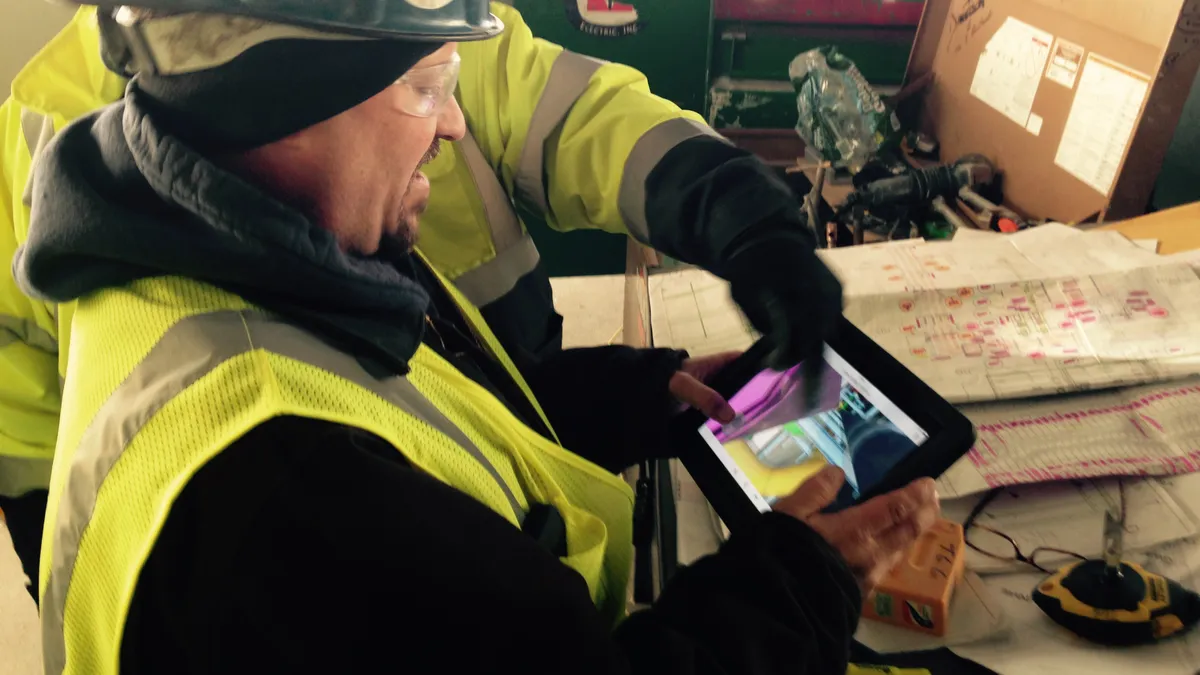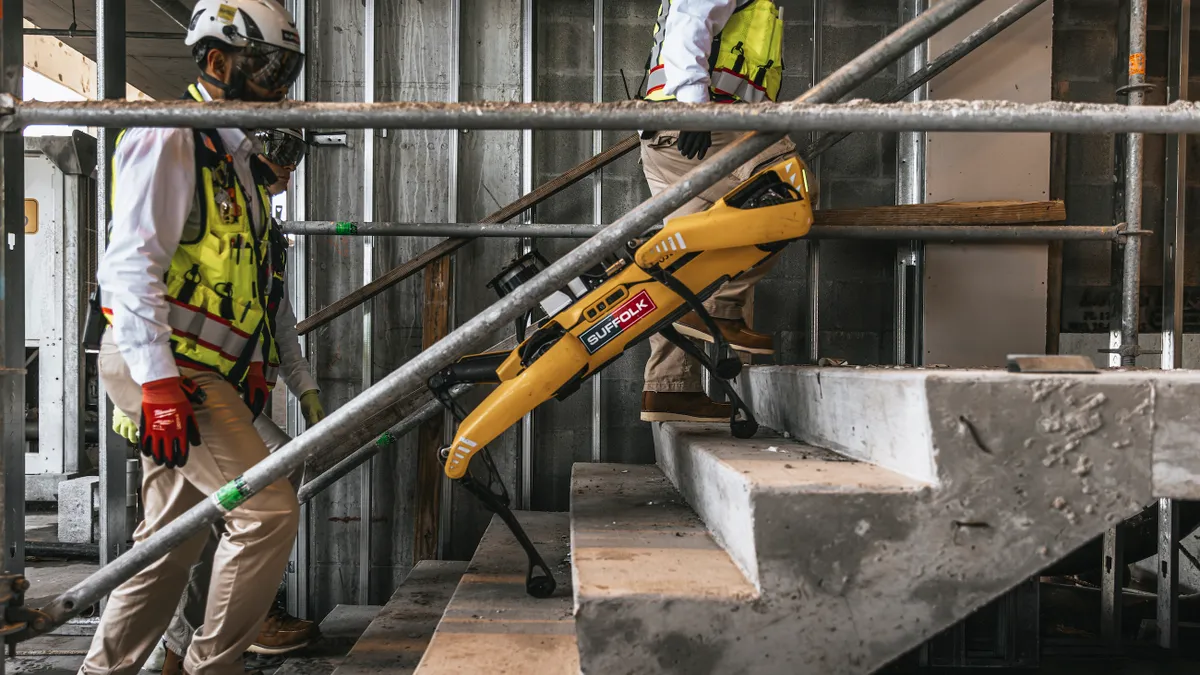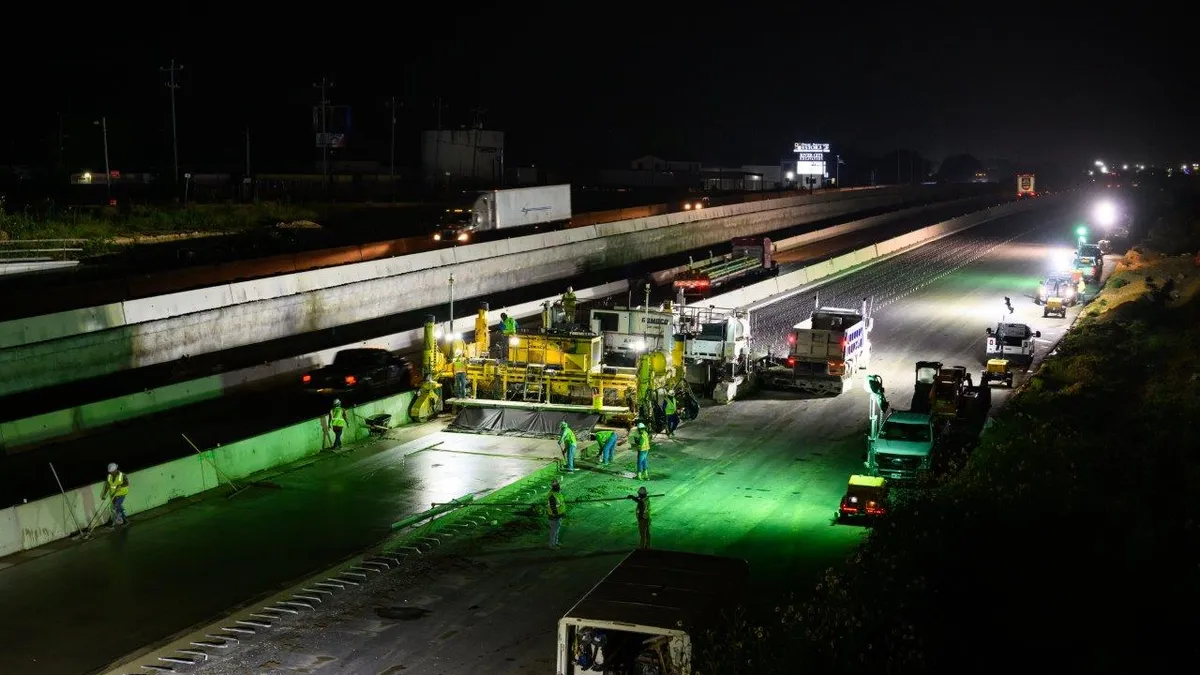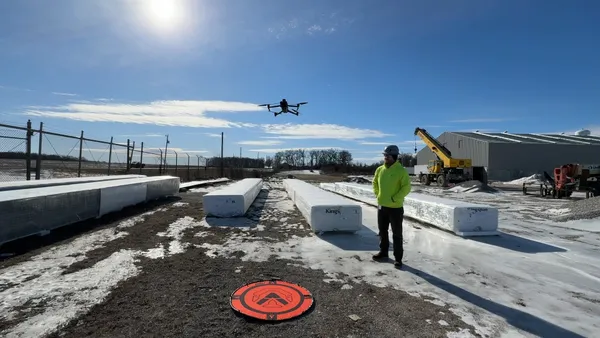The construction industry has seen its fair share of technological advancements in the past few years, with BIM, laser scanning and the proliferation of drones rapidly revolutionizing projects. But the story doesn't end there.
Every day, contractors of all sizes are inundated with the latest and greatest gadgets and software the technology industry can throw at them. They can't implement every new tool presented to them, so how do they decide which ones are worth a shot?
Goals of implementing new technology
"Everything we do, we try to put the client first," Shawmut Design & Construction CEO Les Hiscoe said. Shawmut, he said, strives to be a "leading edge" company and aims to engage its customers in a way that allows them to get to market faster with their product, whether that is a new hospital wing or a university dormitory.
The constant question, he said, is whether or not the company's current technology allows Shawmut employees to accomplish those goals on its more than 500 projects each year. Hiscoe said that as legacy systems become "cumbersome," he and managers work to make sure employees don't get bogged down and are able to deliver the most quality, efficient and speedy experience for the client.
Tony Colonna, senior vice president of innovation construction solutions at Skanska USA, heads up a team dedicated to technology, and as part of the company's "culture of innovation," ideas come from the top down, as well as from the trenches. "A lot of the ideas and a lot of the innovations bubble up from our teams in the field, and part of my role is being visible and doing a little bit of mining for ideas sometimes," Colonna said.
McCarthy Building Companies focuses on delivering customer satisfaction, so the company emphasizes enhanced visualization technology, according to VDC Manager Jordan Moffett. "We're looking at it not only from how is it going to benefit us, but how is it going to make that client's experience more memorable on the project," he said.
Choosing which technologies to adopt
For Shawmut, Hiscoe said that when he and the company's executive team are faced with having to make a decision about whether to give a new innovation a try, they'll whittle down their options — with input from other areas of the company — by measuring how the product meets the widest possible scope of needs.
Then, instead of long study periods, they’ll run pilot tests in the field and use that feedback as part of the decision-making process. Like many companies, Hiscoe said, "We fall into a bit of a trap at times wanting standardization, and that sometimes has led us down the road of one-size-fits-all, and that doesn't work."
Shawmut also has an in-house innovation platform called ShawmutHub that encourages employees to submit ideas for new technologies, as well as operational changes, which are then discussed and vetted by the company's employees. The idea exchange system, Hiscoe said, has already saved the company hundreds of thousands of dollars as a result of cost-cutting suggestions submitted to the Hub.
Skanska's approach to selecting new technology was formalized several years ago, Colonna said, when executives at the company observed field personnel using tablets, a precursor to the widely utilized iPad. "The question was, 'How do you share this knowledge?' 'How do you leverage what's happening on a couple of projects for the company as a whole?'" Colonna said Skanska decided to put "real resources" behind research and development and has invested approximately $2 million into 25 to 30 different projects, ranging from studies to in-house iPhone and iPad applications.
For example, Colonna said that in 2010, Skanska was engaged in a project next to a neonatal unit at Tampa General Hospital in Tampa, FL. There was concern on the part of the company and the hospital staff about noise and dust resulting from construction operations, so Skanska partnered with Duke University to develop a sensor-driven monitor and linked it to an iPhone app so that the hospital staff and project personnel could monitor dust and noise levels 24 hours a day.
McCarthy has a two-part process in looking at "cutting edge" and "innovative" new technology, Moffett said — with one part involving a committee of national VDC managers such as himself who utilize a "divide and conquer" strategy in weeding through "the barrage" of new tech offerings. This approach ensures no two VDC managers are duplicating efforts, he said, and each manager reports back on a regular basis to the others. Once they've decided that a particular technology is worth further consideration, they test it and ultimately begin a slow rollout.
Current game changing innovations
As for current technologies, Shawmut has been testing laser scanning on its massive load of historic preservation work. "We've found laser scanning works amazingly well there," Hiscoe said. He added that the company is currently working on a historic building in Washington, DC, and workers were able to send detailed facade drawings, based on laser scans, to the preservation mason, who ultimately was able to give a much more accurate price than he otherwise would have. Hiscoe said that experience has opened up the company's collective mindset as to what else laser scanning can do, and managers are currently considering using it daily in order to monitor a variety of jobs remotely.
Colonna said Skanska has gone beyond the pilot stage for laser scanning and has started to train employees in different regions to utilize the technology. "Within the last 12 months, I've really seen it go very mainstream," he said. "It's incredible how quickly it's been adopted."
Colonna and Moffett agreed, however, that the one trend that has resulted in the greatest change in the way their companies operate in the field is the proliferation of mobile devices. The use of mobile devices, Colonna said, has caused "a fundamental shift because you have access to information in a quantity and at a speed that you didn't have in the past." He said the learning curve is "dramatically reduced" given the standardization in applications. "You don't have to relearn new applications app to app," he said. "The buttons are the same, the way you gesture, the way you swipe your finger — it all means the same thing."
However, Moffett added one caveat. He said it's easy to be swept away by new technology, but there's a financial danger in rushing to adoption. "The technology's improving so rapidly that it's a concern of ours to make any sort of hefty investment because right around the corner there could be a company that does the same exact thing for a 10th or even a 100th of the cost," he said. But even worse would be passing on a technology "that becomes more mainstream" and finding yourself behind the curve, especially with competitors, Moffett added.
New technologies on the horizon
Hiscoe said drones could play an important role in Shawmut's future, and Moffett said augmented reality, the ability to view an overlay of upcoming work over existing work, is on the horizon for McCarthy. Holograms could even come into play in the not-too-distant future, he added. Colonna pointed to reality capture, real-time location systems and jobsite sensors as technologies Skanska is actively exploring and beta testing.
"We are investing in technology and innovation to bring value to clients as well as to help us internally with our own processes," Colonna said. "The things we were working on today are different than what we were doing two years ago, and I think two years from now they'll still be different as well."





















